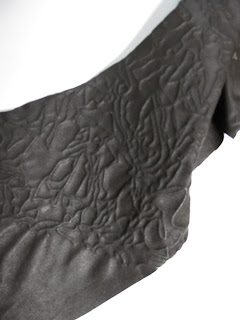 Artist David Batchelor spoke about his studio and how it relates to archival practice. Being surrounded by 'Stuff' and 'Things' are essential to the way he works but much of this 'stuff' has no immediately intended use it's there because it might be useful one day but then again he might throw it out its only value is a value he may or may not place upon it at some point in the future. He evidently considers that his studio would be an archivists nightmare. David's Parapillar 7 is shown left.
Artist David Batchelor spoke about his studio and how it relates to archival practice. Being surrounded by 'Stuff' and 'Things' are essential to the way he works but much of this 'stuff' has no immediately intended use it's there because it might be useful one day but then again he might throw it out its only value is a value he may or may not place upon it at some point in the future. He evidently considers that his studio would be an archivists nightmare. David's Parapillar 7 is shown left.Archivist Anna McNally gave a fascinating insight into the work of archiving an artists belongings. Actually laying hands on the material may take years or can be a phone call that says 'if you can collect it by Friday you can have it, if not it's skipped'. Financial constraints, especially of climate controlled storage, often mean that not everything can be kept and the archivist is forced to make value judgements about what to dispose of. The archival Provenance Principle means that everything should be kept in the order in which it arrived - this is usually irrelevant in the case of artists archives but archivists have to be careful about what associations they make in the way that they catalogue the items. It is the cataloguing process and its attendant links that struck me as being the most interesting part of the work as the archivist comes to know their subject intimately.
 Artist Jamie Shovlin gained a level of notoriety for his artworks that were false archives. Questioning how information gains authority and how interpretation can be highly subjective. 'Naomi V Jelsih' (and anagram of his name) was a work made entirely on an archive that he had created, Naomi never existed, and was created by an equally fictional curator 'John Ivesmail' (also an anagram of his name). As part of the creation of this work a website was created for Naomi including a Gallery of her drawings and newspaper cuttings about her disappearance. A page from one of Naomi's sketch books is shown above. Prior to the exposure of the fiction behind the work it had gained art reviews in national newspapers that praised its scholarship which shows how thoroughly he had researched the archival process.
Artist Jamie Shovlin gained a level of notoriety for his artworks that were false archives. Questioning how information gains authority and how interpretation can be highly subjective. 'Naomi V Jelsih' (and anagram of his name) was a work made entirely on an archive that he had created, Naomi never existed, and was created by an equally fictional curator 'John Ivesmail' (also an anagram of his name). As part of the creation of this work a website was created for Naomi including a Gallery of her drawings and newspaper cuttings about her disappearance. A page from one of Naomi's sketch books is shown above. Prior to the exposure of the fiction behind the work it had gained art reviews in national newspapers that praised its scholarship which shows how thoroughly he had researched the archival process.




